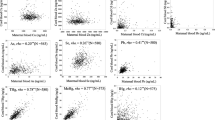Abstract
To evaluate prenatal exposure to arsenic in the general population and its effects on birth size, we conducted a cross-sectional study in Dalian, China. Arsenic concentration in maternal and cord blood was detected by inductively coupled plasma-mass spectrometry and its effects on birth size were analyzed by multivariate analysis and multiple linear regression analysis. Arsenic concentrations in cord blood were significantly lower than those in maternal blood. A significant positive correlation was shown between maternal and cord blood arsenic concentrations. Maternal arsenic concentration was negatively associated with birth weight, height and chest circumference, and fetal arsenic concentration was negatively associated with head circumference. Our results indicate that arsenic exposure at environmental levels in uterus may pose adverse effects on fetal development.


Similar content being viewed by others
References
Gebel T (2000) Confounding variables in the environmental toxicology of arsenic. Toxicology 144:155–162
O'Bryant SE, Edwards M, Menon CV, Gong G, Barber R (2011) Long-term low-level arsenic exposure is associated with poorer neuropsychological functioning: a Project FRONTIER study. Int J Environ Res Publ Health 8:861–874
NRC (National Research Council) (2001) Arsenic in drinking water: update. National Academy Press, Washington, DC
WHO (World Health Organization) (2001) Arsenic and arsenic compounds. International Programme on Chemical Safety, Geneva
Focazio M, Welch AH, Watkins SA, Helsel DR, Horn MA (2000) A retrospective analysis on the occurrence of arsenic in ground-water resources of the United States and limitations in drinking-water-supply characterizations; water-resources investigations report. US Geological Survey, Reston, pp 99–4279
Gong G, O’Bryant SE (2010) The arsenic exposure hypothesis for Alzheimer’s disease. Alz Dis Assoc Disord 24:311–316
Kapaj S, Peterson H, Liber K, Bhattacharya P (2006) Human health effects from chronic arsenic poisoning—a review. J Environ Sci Health, Part A: Tox Hazard Subst Environ Eng 41:2399–2428
Liao C, Shen HH, Chen CL, Hsu LI, Lin TL, Chen SC, Chen CJ (2009) Risk assessment of arsenic-induced internal cancer at long-term low dose exposure. J Hazard Mater 165:652–663
Navas-Acien A, Silbergeld EK, Pastor-Barriuso R, Guallar E (2008) Arsenic exposure and prevalence of Type 2 diabetes in US adults. JAMA 300:814–822
National Academies of Sciences (1999) Arsenic in drinking water. Washington, DC
National Research Council (2001) Arsenic in drinking water: update 2001. Washington, DC
Hopenhayn C, Ferreccio C, Browning SR, Huang B, Peralta C, Gibb H, Hertz-Picciotto I (2003) Arsenic exposure from drinking water and birth weight. Epidemiology 14:593–602
Xu L, Yokoyama K, Tian Y, Piao FY, Kitamura F, Kida H, Wang P (2011) Decrease in birth weight and gestational age by arsenic among the newborn in Shanghai, China. Nippon Koshu Eisei Zasshi 58:89–95
Guan H, Piao FY, Li XW, Li QJ, Xu L, Yokoyama K (2010) Maternal and fetal exposure to four carcinogenic environmental metals. Biomed Environ Sci 23:458–465
Butler Walker J, Houseman J, Seddon L et al (2006) Maternal and umbilical cord blood levels of mercury, lead, cadmium, and essential trace elements in Arctic Canada. Environ Res 100:295–318
Concha G, Vogler G, Lezcano D, Nermell B, Vahter M (1998) Exposure to inorganic arsenic metabolites during early human development. Toxicol Sci 44:185–190
Hall M, Gamble M, Slavkovich V et al (2007) Determinants of arsenic metabolism: blood arsenic metabolites, plasma folate, cobalamin, and homocysteine concentrations in maternal–newborn pairs. Environ Health Perspect 115:1503–1509
Rudge CV, Röllin HB, Nogueira CM, Thomassen Y, Rudge MC, Odland JØ (2009) The placenta as a barrier for toxic and essential elements in paired maternal and cord blood samples of South African delivering women. J Environ Monit 11:1322–1330
Soong YK, Tseng R, Liu C, Lin PW (1991) Lead, cadmium, arsenic, and mercury levels in maternal and fetal cord blood. J Formos Med Assoc 90:59–65
Anderson LM, Diwan BA, Fear NT, Roman E (2000) Critical windows of exposure for children's health: cancer in human epidemiological studies and neoplasms in experimental animal models. Environ Health Perspect 108(Suppl 3):573–594
Anderson LM (2004) Predictive values of traditional animal bioassay studies for human perinatal carcinogenesis risk determination. Toxicol Appl Pharmacol 199:162–174
Wang A, Holladay SD, Wolf DC, Ahmed SA, Robertson JL (2006) Reproductive and developmental toxicity of arsenic in rodents: a review. Int J Toxicol 25:319–331
Vahter M (2008) Health effects of early life exposure to arsenic. Basic Clin Pharmacol Toxicol 102:204–211
Acknowledgements
This research was supported by a Grant-in-Aid for Scientific Research from the Japan Society for the Promotion of Science (Grant No. 18406026), and by the foundation for Scientific Research and Technology, Health Bureau of Dalian (Grant No. 2007-73).
Conflicts of interest
The authors declare they have no conflicts of interest.
Author information
Authors and Affiliations
Corresponding author
Rights and permissions
About this article
Cite this article
Guan, H., Piao, F., Zhang, X. et al. Prenatal Exposure to Arsenic and Its Effects on Fetal Development in the General Population of Dalian. Biol Trace Elem Res 149, 10–15 (2012). https://doi.org/10.1007/s12011-012-9396-7
Received:
Accepted:
Published:
Issue Date:
DOI: https://doi.org/10.1007/s12011-012-9396-7




